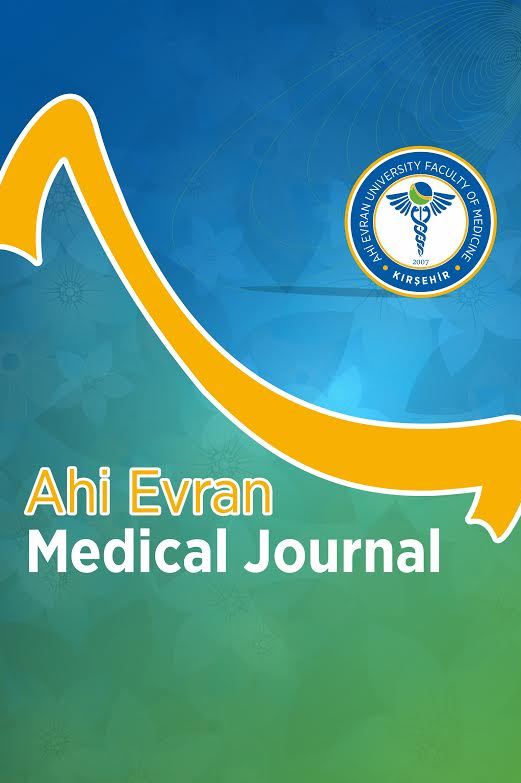Asemptomatik Safra Taşlarında Kolesistektomi Sıklığı ve İlişkili Faktörlerin Araştırılması
akut kolesistit, asemptomatik safra taşı, kolesistektomi
Frequency of Cholecystectomy and Investigation of Related Factors in Asymptomatic Gallstones
acute cholecystitis, cholecystectomy, asymptomatic gallstones,
___
- 1. Ibrahim M, Sarvepalli S, Morris-Stiff G et al. Gallstones:Watch and wait, or intervene? Cleve Clin J Med. 2018;85(4):323-331.
- 2. Stinton LM, Shaffer EA. Epidemiology of gallbladder disease: cholelithiasis and cancer. Gut Liver. 2012;6(2):172-187.
- 3. Lammert F, Acalovschi M, Ercolani G, et al. European Association for the Study of the Liver (EASL). EASL Clinical Practice Guidelines on the prevention, diagnosis and treatment of gallstones. J Hepatol. 2016;65(1):146-181.
- 4. Shaffer EA. Epidemiology and risk factors for gallstone disease: has the paradigm changed in the 21st century? Curr Gastroenterol Rep. 2005;7(2):132-140.
- 5. Njeze GE. Gallstones. Niger J Surg. 2013;19(2):49-55.
- 6. Portincasa P, Di Ciaula A, De Bari O, Garruti G, Palmieri VO, Wang DQ. Management of gallstones and its related complications. Expert Rev Gastroenterol Hepatol. 2016;10(1):93-112.
- 7. Baron TH, Grimm IS, Swanstrom LL. Interventional Approaches to Gallbladder Disease. N Engl J Med. 2015;373(4):357-365.
- 8. Quintana JM, Cabriada J, Aróstegui I et al. Health-related quality of life and appropriateness of cholecystectomy. Ann Surg. 2005;241(1):110-118.
- 9. Quintana JM, Cabriada J, Lopez DT, et al. Development of explicit criteria for cholecystectomy. Qual Saf Health Care. 2002;11(4):320-326.
- 10. Noel R, Arnelo U, Enochsson L, Lundell L, Nilsson M, Sandblom G. Regional variations in cholecystectomy rates in Sweden: impact on complications of gallstone disease. Scand J Gastroenterol. 2016;51(4):465-471.
- 11. Murshid KR. Asymptomatic gallstones: Should we operate? Saudi J Gastroenterol 2007;13(2):57-69.
- 12. Lamberts MP. Indications of cholecystectomy in gallstone disease. Curr Opin Gastroenterol 2018;34(2):97-102.
- 13. Lamberts MP, Lugtenberg M, Rovers MM, et al. Persistent and de novo symptoms after cholecystectomy: a systematic review of cholecystectomy effectiveness. Surg Endosc. 2013;27(3):709-718.
- 14. Karmacharya A, Malla BR, Joshi HN, et al. The predictive value of pre-operative symptoms including upper gastrointestinal endoscopy before laparoscopic cholecystectomy for elective symptomatic cholecystolithiasis. Kathmandu Univ Med J. 2013;11(4):300-304.
- 15. Quintana JM, Cabriada J, López de Tejada I, Perdigo L, Aróstegui I, Bilbao A. Appropriateness variation in cholecystectomy. Eur J Public Health. 2004;14(3):252-257.
- Yayın Aralığı: Yılda 3 Sayı
- Başlangıç: 2017
- Yayıncı: Kırşehir Ahi Evran Üniversitesi
Sercan ÖZKAÇMAZ, İlyas DÜNDAR, Nazım KANKILIÇ, Mesut ÖZGÖKÇE, Abdullah GÜL, Rahmi ASLAN
Doğum Şeklinin Umbilikal Kord Kanındaki Tiyol-Disulfid Dengesine Etkisi
Selda SONGUR DAĞLI, Recai DAĞLI
Laparoskopik Sleeve Gastrektomi Sonrası Morbid Obez Hastalarda Akdeniz Diyetinin Etkinliği
Mehmet Nuri KOŞAR, Umut R. GÜNDÜZ, Onur İlkay DİNÇER, Tuğrul ÇAKIR
Tekrarlayan Gebelik Kayıplı Hastalarda Kromozom Analizinin Yeri
Burhan BALTA, Murat ERDOĞAN, Aslıhan KİRAZ, Zeki YILMAZ
Covid 19 Pandemisi Sırasında Kullanılan Farmakolojik Ajanların Gözden Geçirilmesi.
Postoperatif Pulmoner Komplikasyonların Öngörülmesinde Belirteç Karşılaştırılması; Asa ve Ariscat
Nd:YAG Lazer Onikomikoz Tedavisinde Etkili midir?
Serkan DÜZAYAK, Orhan ÖZGÖZTAŞI
Sağlıklı Bireylerde İki Farklı Optik Koherens Tomografi Anjiografi Cihazının Karşılaştırılması
Sebile ÇOMÇALI, Cemal ÇAVDARLI, Mehmet Numan ALP
Editöre Mektup: Kaptoprile Bağlı Gelişen Akut Pankreatit: Olgu Sunumu
Asemptomatik Safra Taşlarında Kolesistektomi Sıklığı ve İlişkili Faktörlerin Araştırılması
Ali KIRIK, Ali Cem YEKDEŞ, Uğur ERGÜN, Burak ALP, Merve Nur AK, Teoman DOĞRU
